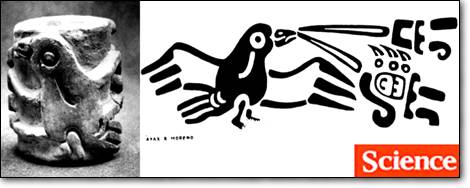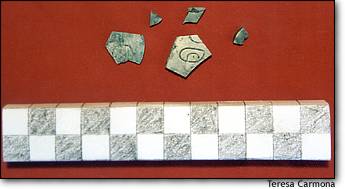MSNBC
December 5, 2002
Roots traced back to glyphs of Mexico’s Olmec civilization
By Laura Kennedy
SCIENCE

The photo shows a cylinder seal that was discovered at an
Olmec site at San Andréas in
Mexico. The image at right shows what would be printed when the seal is
inked and rolled out. The
bird appears to be "speaking" the markings at far right. Among the markings
are symbols for kingship
and a calendar date, and researchers say they probably represent the name
of an Olmec king.
WASHINGTON, Dec. 5 — The roots of writing in the
New World have been traced back to a time
earlier than researchers thought — as far back as
2,650 years, when the ancient Olmec civilization
flourished on Mexico’s Gulf Coast, according to
a study in the journal Science, published by the
American Association for the Advancement of
Science.
WITH THEIR COMPLEX urban centers, their huge
clay and earth pyramids, and their focus on royal rituals, the
Olmec have long been recognized for laying the foundations
of the later Maya and Aztec cultures. Now, researchers
have added the development of writing in the New World
to the list of Olmec “firsts.”
Until now, the earliest evidence of writing in the New
World seemed to come from Zapotec settlements in nearby
southwestern Mexico. A monument from that area bearing
two glyphs was originally dated at 600 to 500 B.C., but
now an origin between 300 B.C. and A.D. 200 seems more
likely.
Recently Mary Pohl of Florida State University in
Tallahassee and colleagues Kevin Pope of Geo Eco Arc
Research and Christopher von Nagy of Tulane University
uncovered two glyph-bearing artifacts near La Venta, the
Olmec’s major royal center after 850 B.C. The ceramic
cylinder and greenstone plaque date to about 650 B.C.
Pohl’s team concludes that the graphics covering them are
not simply drawings but rather represent spoken language
and are therefore true writing.
“The Olmecs crystallized and formalized Central
American culture through the institution of kingship, and
writing was an integral part of that,” said Pohl. So it makes
sense, she said, that the Olmec were the first in the New
World to develop a written language, which would be
adapted and refined by those who followed.
FROM OBJECTS TO CONCEPTS
As far as researchers know, writing developed
independently at least five times: in present-day Iraq, Egypt,
China, Pakistan and Central America. Most experts credit
the ancient Middle Easterners with the earliest script, which
was pressed into clay tablets by about 3,000 B.C.
The earliest scribes in the Middle East seem to have
been interested primarily in accounting. Their missives tallied
livestock sold, foodstuffs delivered, taxes paid and the like.
In most cases, true writing evolved from simple iconography, in
which drawings depict objects or people. Over time, symbols took on
more complex meanings and came to represent words or concepts.
The Olmec have long been recognized as the
first significant civilization to develop in Central America.
Their political-religious centers, spreading from huge
ceremonial mounds, were the model for later sites like the
Maya’s famed Tikal and Chichén Itzá. Later cultures also
adopted the Olmec’s system of kingship, which was based
in part on military conquest.
The Olmec are also known for their monumental stone
artworks, including colossal heads weighing up to 40 tons
as well as stelae and statues. Excavated among the remains
of a great feast, the artifacts found by Pohl’s group are also
works of art.
Although they are on a considerably smaller scale than
some Olmec art, the new artifacts were nevertheless
designed for showing off. The ceramic cylinder, about 3
inches (8 centimeters) tall, would have been inked and
rolled over skin or clothing to leave a printed image,
according to Pohl. The greenstone plaque was probably
worn as jewelry.
MESSAGES FROM THE PAST
To interpret writing in an unknown ancient language,
experts like Pohl and her colleagues work backwards from
more recent texts, looking for similarities in the shape and
use of various glyphs.
The rollout from the ceramic seal depicts a bird with a
series of glyphs coming from its beak. Although it is not yet
possible to translate the message in its entirety, one of the
elements is a U-shaped glyph that in later periods was used
to represent rulership. Another resembles a glyph for a
specific date in the sacred 260-day calendar that guided
daily life of the Maya.
Because it was a Mesoamerican practice to use birth
day names as personal names, Pohl concluded, “the
message on the cylinder is the name of a king. It was a way
of justifying, of propping up power.” Moreover, the early
reference to the sacred calendar indicates that this Mayan
system also evolved from an Olmec prototype, Pohl said.
In part because the glyphs on the cylinder seem to
emanate from the bird’s beak, like text in a modern-day
cartoon bubble, the authors contend that they clearly signify
spoken words and thus represent true writing. “We’re
making the argument that this is not just iconography,” Pohl
said.
The glyphs on the greenstone plaque are harder to
decipher. Yet both the material and the symbols resemble
those found in later artifacts from various regions, providing
further evidence that the Olmec’s writing formed the basis
for later scripts in several Central American cultures.

Greenstone plaque fragments with early glyphs were found
at the
San Andréas site. The fragments were probably from high-status
jewelry of the time, researchers say. The bar at the bottom of the
images provides a metric scale -- the largest fragments are about 9
millimeters wide.
OF KINGS AND CALENDARS
In contrast to the economic focus of the earliest Middle
Eastern texts, the impetus for Olmec writing appears to
have been political: the crowning of kings, associated rituals
and the calendar to track them.
“What we’re seeing is how rulers gained power,” said
Pohl. “The Olmecs were the first Mesoamericans to have
the pyramids, urban centers, and writing. It’s all tied
together in terms of the emergence of kings.”
© 2002 by the American Association for the
Advancement of Science

